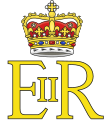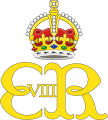Royal cypher

In modern heraldry, a royal cypher is a monogram or monogram-like device of a country's reigning sovereign, typically consisting of the initials of the monarch's name and title, sometimes interwoven and often surmounted by a crown.[1] Such a cypher as used by an emperor or empress is called an imperial cypher. In the system used by various Commonwealth realms, the title is abbreviated as 'R' for 'rex' or 'regina' (Latin for "king" and "queen"). Previously, 'I' stood for 'imperator' or 'imperatrix' (Latin for "emperor" and "empress") of the Indian Empire.[2][3]
Royal cyphers appear on some government buildings, impressed upon royal and state documents, and are used by governmental departments. They may also appear on other governmental structures built under a particular ruler. For example, the insignia of "N III" for Napoléon III is seen on some Paris bridges, such as the Pont au Change.
Commonwealth realms
The use of a royal cypher in the
The initials – which had no set pattern or form of lettering laid down – were usually shown in company with the royal arms or crown as on the king's manors and palaces – such as those of Henry VIII on the gatehouse of
Though royal symbols (including, most notably, the coat of arms,
Charles III
On 26 September 2022, Buckingham Palace unveiled the cypher of the new king, Charles III, that is gradually replacing the cypher of Elizabeth II in everyday use. The design was selected by Charles himself from a series of designs prepared by the College of Arms and features the King's initial "C" intertwined with the letter "R" for Rex with "III" denoting Charles III, with a Tudor Crown above the letters.[5][6] Charles's Scottish cypher uses the Crown of Scotland instead.[5][7]
-
King Charles III's royal cypher surmounted with a Tudor Crown
-
King Charles III's royal cypher surmounted by the Crown of Scotland
-
Dual cypher of King Charles III and Queen Camilla
-
Royal cypher of Queen Camilla, consort of King Charles III
Elizabeth II
The late queen's cypher was EIIR, standing for Elizabeth II Regina.[8] Elizabeth's cypher was usually surmounted by a stylised version of St. Edward's Crown. In Scotland, as a result of the 'Pillar Box War', which was a dispute over the correct title of the new monarch (Elizabeth I of England and Ireland was not a monarch of Scotland, so the new queen would have been Elizabeth I, not II, in Scotland according to that view), after 1953 new post boxes carried only the Crown of Scotland image rather than the EIIR cypher, which continued to be used in the rest of the United Kingdom and in the other realms and territories.
The production of the cypher was an early step in the preparations for her coronation in 1953 as it had to be embroidered on to the uniforms of the Royal Household and on other articles.[9] Cyphers for other members of the royal family are designed by the College of Arms or Court of the Lord Lyon and are subsequently approved by the monarch.[10]
-
Queen Elizabeth II's royal cypher, surmounted bySt Edward's crown
-
Queen Elizabeth II's royal cypher, surmounted by the Crown of Scotland
-
One example of a dual cypher for Queen Elizabeth II and Prince Philip, which appeared on a 1972 coin commemorating their 25th wedding anniversary
-
Royal monogram of Prince Philip, consort of Queen Elizabeth II
Other monarchs
See the Gallery section for example of the cyphers of other monarchs.
Canada
The royal cyphers have been incorporated by the Canadian Heraldic Authority into the various royal standards of Canada. The use in Canada of the reigning monarch's cypher, which is sometimes uniquely surrounded by a garland of maple leaves, is as a symbol not only of the sovereign him- or herself, but of Canada's full sovereignty.[11]
Australia
The royal cypher is also found on post offices and some government buildings in Australia.[citation needed]
Elsewhere
British royal cyphers are still visible on several public buildings and old
Other royal houses have also made use of royal or imperial cyphers;
All the monarchs of
King
Gallery
-
ThePalaeologiin the centre
-
Royal monogram of King Stephen I of Hungary
-
Arms of theFriedrich I of Prussiaat the centre
-
The cypher of Dubai Sovereign H.H. Maktoum bin Rashid Al Maktoum
-
Cypher ofMaha Vajiralongkorn of Thailand
-
Cypher of George I of Greece
-
The cypher ofArabic numeral'2'
-
A railing with the royal cypher of King William IV
-
The royal and imperial Cypher of Queen Victoria forms a part of the emblem of the Royal Victorian Order surrounded by a Brunswick star
-
The royal cypher of King Edward VII, using the Tudor Crown
-
The royal and imperial cypher of KingEdwardus Rex Imperator, used on an Indian railway wagon
-
Royal cypher of King George V, using the Tudor Crown
-
A Hong Kong mailbox with a cypher of King George V
-
The royal cypher of King Edward VIII, using the Tudor Crown
-
The most common variant ofKing George VI's cypher
-
The royal cypher ofQueen Elizabeth II, using St Edward's Crown
-
Variant Queen Elizabeth II cypher inArabic instead of Romannumerals typically employed
-
Base of aKing Ferdinand VII
-
Royal cypher (monogram) of Catherine II
-
The monogram of Charles III of Brabant
-
The royal cypher of King Carol II of Romania (two opposed Cs) decorates the porch roofs at the entrances in the Royal Palace of Bucharest.
-
Royal cypher of King Michael I of Romania
-
Royal cypher of Margareta of Romania
-
Royal cypher of KingFelipe VI of Spain
-
Royal cypher of QueenMargrethe II of Denmark
-
Royal cypher of KingCarl XVI Gustaf of Sweden
-
Great Seal of Gojong of Korea
-
Coat of arms of House of Yi of Korea
-
Royal cypher of KingHarald V of Norway
-
Royal cypher ofGrand Duke Henri of Luxembourg
-
Royal cypher of King Umberto II of Italy
-
Royal cypher of King Nicholas I of Montenegro
-
A door in the Palace of São Cristóvão with cyphers of Emperor Pedro II of Brazil
See also
- Flags of Elizabeth II
- H7 (monogram)
- Heraldic badge
- MacCormick v Lord Advocate
- Mon (emblem)
- Royal sign-manual
- Signum manus
References
- ^ The Shorter Oxford English Dictionary (Fifth edition; 2002), Volume 1, p. 1820.
- ^ Morley, Vincent. "United Kingdom: Royal Navy". Flags Of The World. Retrieved 30 October 2009.
- ^ Boutell, Charles; Wheeler-Holohan, V. (1931). Boutell's Manual of Heraldry. Detroit: F. Warne and Co. Ltd. p. 244. Retrieved 30 October 2009.
- ISBN 978-1-4068-2770-5.
- ^ a b The Royal Household (2022-09-27). "His Majesty The King's cypher". The Royal Family. Retrieved 2022-09-27.
- ^ "New King Charles royal cypher revealed". BBC. 26 September 2022.
- ^ Grierson, Jamie (26 September 2022). "King Charles III's official monogram design released by palace". The Guardian. Retrieved 26 September 2022.
- ^ "Royal Cypher of Queen Elizabeth ll". The Morning Bulletin. 1952-07-18. p. 1. Retrieved 2021-04-27.
- ^ "Vintage Reader's Digest 1953: Preparing to Crown a Queen - Reader's Digest". www.readersdigest.co.uk. Retrieved 2021-04-27.
- ^ Palmer, Richard (2009-01-07). "Prince Harry pays tribute to Diana with royal cypher". Express.co.uk. Retrieved 2021-04-27.
- ISBN 978-0-662-46012-1.
- ISBN 9781514471333– via Google Books.
- ^ "Royal Ciphers on Postboxes: a Brief Guide". April 1, 2018.









































